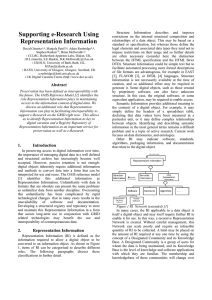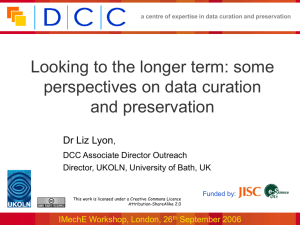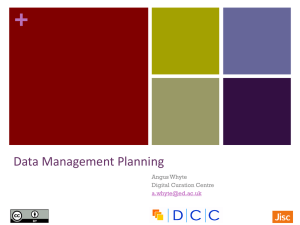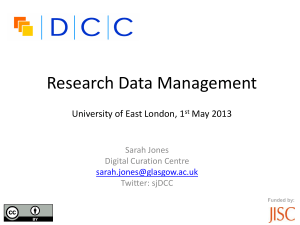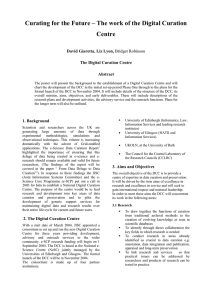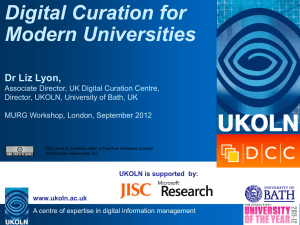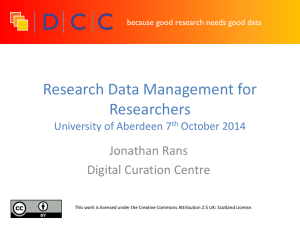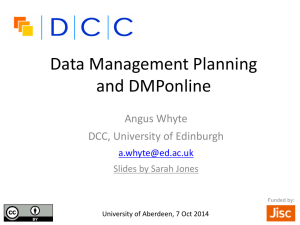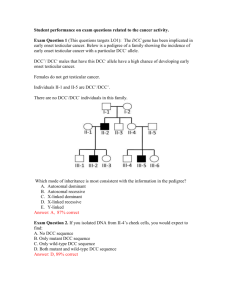Supporting e-Research Using Representation Information
advertisement
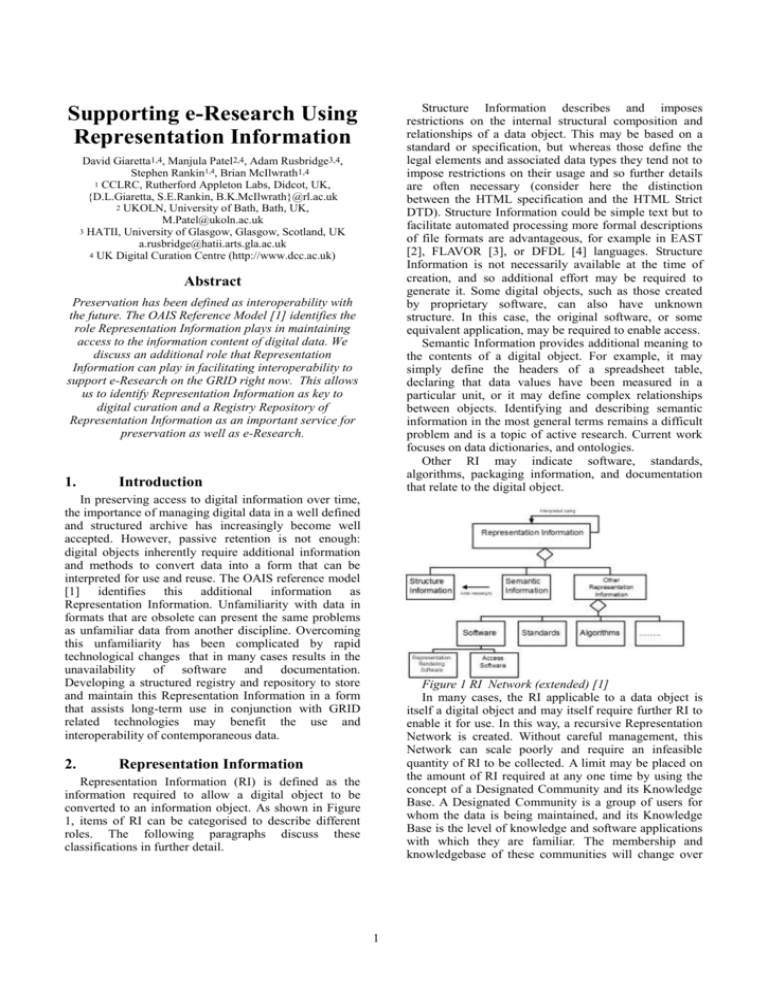
Structure Information describes and imposes
restrictions on the internal structural composition and
relationships of a data object. This may be based on a
standard or specification, but whereas those define the
legal elements and associated data types they tend not to
impose restrictions on their usage and so further details
are often necessary (consider here the distinction
between the HTML specification and the HTML Strict
DTD). Structure Information could be simple text but to
facilitate automated processing more formal descriptions
of file formats are advantageous, for example in EAST
[2], FLAVOR [3], or DFDL [4] languages. Structure
Information is not necessarily available at the time of
creation, and so additional effort may be required to
generate it. Some digital objects, such as those created
by proprietary software, can also have unknown
structure. In this case, the original software, or some
equivalent application, may be required to enable access.
Semantic Information provides additional meaning to
the contents of a digital object. For example, it may
simply define the headers of a spreadsheet table,
declaring that data values have been measured in a
particular unit, or it may define complex relationships
between objects. Identifying and describing semantic
information in the most general terms remains a difficult
problem and is a topic of active research. Current work
focuses on data dictionaries, and ontologies.
Other RI may indicate software, standards,
algorithms, packaging information, and documentation
that relate to the digital object.
Supporting e-Research Using
Representation Information
David Giaretta1,4, Manjula Patel2,4, Adam Rusbridge3,4,
Stephen Rankin1,4, Brian McIlwrath1,4
1 CCLRC, Rutherford Appleton Labs, Didcot, UK,
{D.L.Giaretta, S.E.Rankin, B.K.McIlwrath}@rl.ac.uk
2 UKOLN, University of Bath, Bath, UK,
M.Patel@ukoln.ac.uk
3 HATII, University of Glasgow, Glasgow, Scotland, UK
a.rusbridge@hatii.arts.gla.ac.uk
4 UK Digital Curation Centre (http://www.dcc.ac.uk)
Abstract
Preservation has been defined as interoperability with
the future. The OAIS Reference Model [1] identifies the
role Representation Information plays in maintaining
access to the information content of digital data. We
discuss an additional role that Representation
Information can play in facilitating interoperability to
support e-Research on the GRID right now. This allows
us to identify Representation Information as key to
digital curation and a Registry Repository of
Representation Information as an important service for
preservation as well as e-Research.
1.
Introduction
In preserving access to digital information over time,
the importance of managing digital data in a well defined
and structured archive has increasingly become well
accepted. However, passive retention is not enough:
digital objects inherently require additional information
and methods to convert data into a form that can be
interpreted for use and reuse. The OAIS reference model
[1] identifies this additional information as
Representation Information. Unfamiliarity with data in
formats that are obsolete can present the same problems
as unfamiliar data from another discipline. Overcoming
this unfamiliarity has been complicated by rapid
technological changes that in many cases results in the
unavailability of software and documentation.
Developing a structured registry and repository to store
and maintain this Representation Information in a form
that assists long-term use in conjunction with GRID
related technologies may benefit the use and
interoperability of contemporaneous data.
2.
Figure 1 RI Network (extended) [1]
In many cases, the RI applicable to a data object is
itself a digital object and may itself require further RI to
enable it for use. In this way, a recursive Representation
Network is created. Without careful management, this
Network can scale poorly and require an infeasible
quantity of RI to be collected. A limit may be placed on
the amount of RI required at any one time by using the
concept of a Designated Community and its Knowledge
Base. A Designated Community is a group of users for
whom the data is being maintained, and its Knowledge
Base is the level of knowledge and software applications
with which they are familiar. The membership and
knowledgebase of these communities will change over
Representation Information
Representation Information (RI) is defined as the
information required to allow a digital object to be
converted to an information object. As shown in Figure
1, items of RI can be categorised to describe different
roles. The following paragraphs discuss these
classifications in further detail.
1
time, and there will also be technological changes that
take place. As a result of these changes the RI required
will change.
By sharing the collection of RI between organisations,
the effort required may be reduced, and the feasibility of
collection increased. The Designated Community will
have to be monitored in some way to ensure the
Representation Information continues to be suitable for
its needs. As an example of Representation Information,
consider an astronomical image in FITS file format [5].
This contains a header with keyword value pairs, where
each keyword has a specific meaning, although only a
small number of these keywords are standardised. The
Semantic Information should explain the context of each
keyword.
In many instances, this reuse may entail the mapping of
information
between
structures
to
facilitate
interoperability. Between, and even within disciplines,
these methods are often not shared through a dedicated
infrastructure. Sharing this RI increases access to
resources and reduces the cost involved in transforming
data into a structure suitable for specific purposes.
3. The DCC Representation Information
Registry and Repository
In order to help to avoid duplication, share resources,
coordinate access, and minimise effort, a dedicated and
well engineered network of Representation Information
Registry-Repositories (RI-RRs) are needed. The DCC is
actively developing a Representation Information
Registry (DCC- RR). This is not intended to be a data
repository, but an authoritative source of RI for the
community responsible for the collection, curation, and
management of data.
We see our primary function as providing and sharing
information that enables managers of digital information
to make informed decisions with regards to curation
strategies. The DCC-RR aims to make relevant RI
available in a readily accessible manner to enable third
parties to make informed decisions with regard to the
management of their data [6].
An early prototype Representation Information
Registry (DCC-RR) is currently available, intended as a
proof-of-concept demonstrator [7]. The ideas behind
this approach are detailed in the document, DCC
Development Approach to Digital Curation [8]. At
present the prototype DCC-RR caters for: viewing RI
already registered; registering of new RI; creation of a
new RI Label; and adding a classification entry.
We plan to work with projects such as PRONOM,
developed by the National Archives, and the Global
Digital Format Registry (GDFR), developed by the
Digital Library Federation (DLF). These focus on the
provision of details about formats – essentially limited to
the Structure type of RI. These projects will help to
inform the development of the DCC-RR, and strategies
are being developed to ensure the data contained within
the DCC-RR is interoperable with these.
2The file in FITS format would be easily understood
by someone who knew how to handle this format,
someone who’s Knowledge Base includes FITS (for
example, they have some appropriate software). Without
this knowledge, additional RI would be needed.
Additional RI will take the form of software to display
the image (which may need additional RI in the form of
an emulator) or a human-readable standard describing
the FITS file format.
2.1 The Long Term Role of Representation
Information
Without maintaining and retaining suitable RI, the
difficulties of preservation of information, as opposed to
bytes, are increased. Data formats, software, standards,
and programming languages become obsolete; the
documentation for these are often poor or non-existent;
and the specialised knowledge needed to manipulate
these is often not externalised.
Submitters of data to an archive must be able to
identify the RI needed by the end users. Policies must be
developed specifying how suitable and comprehensive
RIAlthough RI allows the formal identification of the
composition of a digital object and indicates an
environment in which the data was previously used, it
may be difficult to encourage submitters of data to
provide corresponding RI. Licensing restrictions may
limit the availability of some essential objects. The
additional step of RI collection in the workflow process
may restrictively increase the cost of archiving. In order
to overcome these issues, clear policies of retention and
efforts towards workflow streamlining are needed.
3.1 Representation Information Labels
RI should be stored in a well defined and managed
Registry/Repository (RI-RR) system, with appropriate
metadata describing it.
A digital object should be associated with a structured
label as a necessary (but not sufficient) condition for
long-term preservation, through a type of logical
attachment or packaging. This label, such as that
described in [9], allows the identification and
categorisation of RI and provides a set of entry points
into the DCC-RR. As each RI object has an associated
label identifying suitable rendering conditions, a directed
Representation Net can be created.
2.2 Contemporaneous use of Representation
Information
RI by definition is what is needed to facilitate use and
reuse of digital information. The RI may be limited, but
adequate for a contemporary Designated Community.
However for contemporary users outside the Designated
Community, this RI may be sufficient to obtain further
contemporary resources. Alternatively additional RI may
be provided to support this broader Community.
2
For long-term preservation each entry of RI should be
identified with a persistent identifier. A label, which can
be attached to either a data object in an external
repository or an RI object internally in the RI-RR, then
contains a set of identifiers. This label then serves as a
set of entry points into the RI-RR, allowing the
Representation Network to be traversed and the
appropriate RI discovered. Ideally, this operation will be
automated and transparent to the end user. The variety of
formats, software, specialised subjects, and user
communities that exist indicates that a distributed
network of Registries may be needed. We hope that any
foundations laid now may develop into a distributed,
global, and federated collaborative system.
In the long term, we hope to develop identification
services for the DCC-RR which allow a user to submit
an object which is then identified and an appropriate
label returned.
The EAST language is well supported with tools to
aid the production of EAST descriptions and associated
Data Dictionaries. Accordingly, we are in the process of
integrating EAST tools into the DCC-RR to enable us to
get from bit level representations to primitive objects.
5. Web Services
Current development of the DCC-RR suggests that a
network of geographically distributed and federated
repositories will be able to contain the greatest level of
knowledge, providing the most complete level of
support. Access to RI should facilitate the use and re-use
of digital information across disciplines, as is
increasingly likely in e-Research. In particular we are
developing a number of generic applications and APIs
which will allow one to perform useful operations on
digital information from unfamiliar domains, in
unfamiliar formats, given adequate RI. A particular type
of such an application can be used to provide services
such as format transformation. These will be available as
Web Services, and we further hope to collaborate with
and build upon the work of the PANIC [10] project.
4. Interoperability and Automated
Processing
The interconnected nature of the Representation
Network and the complexity of software mean that
where possible automated processing should be
emphasised. This scenario is clearer when considering
science formats, many of which are designed for
automated processing by a parsing program. To handle
an “unfamiliar bit stream” without using specially
written software one would need a way to describe data
at different levels of abstraction, for example from the
bit level to complete information objects (see Figure 2),
for use in general purpose applications and interfaces
which will support interoperability.
6. Use of Representation Information in the
GRID
The use of the GRID and e-Research in general will
make use of “unfamiliar bit streams” in the form of data
relevant to a piece of research but perhaps not in a
familiar discipline. It is important that this data is
interpreted correctly by the user. RI provides access to
methods that will further the ability of users to interpret
this data. In addition, in order to support processing of
potentially large amounts of such information with tools
familiar to the user, as far as possible the RI should make
the data usable by the user’s general purpose software.
7. Benefits for e-Research
Concerns regarding information preservation are
growing, particularly within the field of e-Science where
the costs involved in data production are significant. The
methods by which information is interpreted are likely to
change over time, and so maintaining a structured
repository record of RI ensures previously methods can
be accessed and viewed for strengths and weaknesses,
allowing the most appropriate use, or recreation, of
some particular functionality. By developing an
environment in which data descriptions can operate in
conjunction with web services and GRID applications,
the ability to share and automate the use of information
is facilitated.
Figure 3 Role of Representation Information
8. Conclusions
We are investigating the use of data description
languages such as EAST [2] and DFDL [4] to describe
structure information in detail, and how these may be
used to map between alternative formats.
RI is a key idea in managing and using distributed
digital data as well as preserving digital information over
the long-term. The UK Digital Curation Centre is
3
working on this basis for a globally distributed network
of Registry/Repository for Representation Information
which will support both these types of activities. Key
concepts relating to interoperability, automated use, and
web services have been identified, and development
work is ongoing to implement these. These ideas show
the dual use to which RI can be put, namely preservation
activities as well as e-Research using contemporaneous
data.
References
1. ISO 14721, Reference Model for an Open Archival
Information Model,
http://www.ccsds.org/documents/650x0b1.pdf
2. EAST, ISO 15889, http://east.cnes.fr/
3. FLAVOR, http://flavor.sourceforge.netDFDL,
http://forge.gridforum.org/projects/dfdl-wg/
4. FITS Format, http://fits.gsfc.nasa.govDCC
Development Team Report, Scoping Study for a Standards
Registry,
http://dev.dcc.ac.uk/twiki/bin/view/Main/DCCStandardsRe
gistryDCC Development Team, DCC-RR Development,
http://dev.dcc.rl.ac.uk/dccrrt/
5. DCC Development Team, DCC Approach to Digital
Curation,
http://dev.dcc.rl.ac.uk/twiki/bin/view/Main/DCCApproachT
oCuration
6. DCC Development Team, DCC Label Report,
http://dev.dcc.rl.ac.uk/twiki/bin/view/Main/DCCInfoLabelR
eport
7. Semi-Automated Preservation and Archival of
Scientific Data using Semantic Grid Services; Hunter, J.
and Choudhury, S. May, 2005,
http://metadata.net/newmedia/Papers/SIGAW2005_paper.p
df
4
